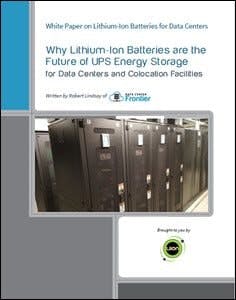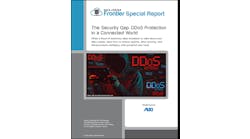Lithium Iron Phosphate – The Ideal Chemistry for UPS Batteries?
In the last entry in the four-part Data Center Frontier Special Report Series that explores the future of lithium-ion batteries and their impact on energy storage, we discover why lithium iron phosphate acts is an ideal chemistry for UPS batteries.
Download the full report.
The ideal lithium chemistry to use in UPS batteries for data centers is lithium iron phosphate (LiFePO4 or LFP). When compared to other lithium battery chemistries, lithium iron phosphate can offer the best mix of safety, performance, longevity, and cost effectiveness.
Safety
Lithium iron phosphate is a very stable chemistry, which makes it safer to use as a cathode than other lithium chemistries. Lithium iron phosphate provides a significantly reduced chance of thermal runaway, a condition that occurs when the chemical reaction inside a battery cell exceeds its ability to disperse heat, resulting in an explosion. Thermal runaway may be caused by overcharging, an internal fault, physical damage to the battery, or a hot environment.
If a fire occurs with an LFP battery, it can be extinguished by an ordinary water sprinkler system.
Lithium iron phosphate has a thermal runaway temperature of 518°F (270°C), which is much higher than other lithium battery chemistries. LFP batteries can deliver rapid discharge and recharge while generating very little heat. They require less ventilation or cooling, and can withstand higher temperatures without decomposing. When exposed to air due to an accident (e.g. piercing of the battery casing), the lithium iron phosphate chemistry will not react with oxygen, and therefore will not cause an explosion or fire.
Lithium iron phosphate is very stable because it contains no cobalt, which is a chemically unstable element. The chemistries in lithium cobalt oxide and lithium manganese cobalt batteries break down at much lower temperatures and release far more potentially hazardous energy. Cobalt-based lithium batteries actually generate heat in their normal battery operation, which increases the risk of thermal runaway. There is no effective fire retardant against a cobalt fire; your only option is to let the fire burn itself out. But if a fire occurs with an LFP battery, it can be extinguished by an ordinary water sprinkler system.
Also, the Battery Management System in LFP batteries allows you to monitor internal battery temperature. This gives you full control of charging and discharging, protecting you from overcharging and overheating, and preventing unsafe temperatures inside the lithium-ion cells. Additionally, lithium iron phosphate batteries usually have a durable battery design and cell packaging, manufactured to comply with national safety standards.
Longer Lifespan and Cycle Life
Lithium iron phosphate batteries have a lifespan of about 15 years in UPS applications; they may last for the entire 12-to-15-year lifetime of your UPS system. This fully eliminates the high cost of replacing lead acid batteries every 3-4 years. Fully-charged LFP batteries can be put in storage with little change to the total lifespan of the battery’s charge.
Also, LFP batteries have a cycle life of up to 3,000 discharges, which is 15 times the normal cycle life of lead acid batteries (200 discharges), and also longer than most other lithium battery chemistries, which may offer between 500 and 2,000 discharges.
Lithium iron phosphate batteries have faster discharge rates, which means they are capable of delivering large amounts of power in a very short time. This is crucial in UPS applications. During a data center power outage, UPS batteries must quickly and efficiently deliver large amounts of power to the UPS to keep the facility running during the 10-12 second automatic switchover to auxiliary power. If the batteries can’t deliver the current fast enough, the UPS can fail, and power to the facility will shut down.
An LFP battery is capable of a 2-minute (30C) discharge rate, meaning it can discharge its entire capacity in two minutes. A 10-12 second changeover period will not fully drain the battery’s power capacity, but during this period, the LFP battery can quickly deliver the necessary higher voltage power that the UPS requires. Also, an LFP battery provides up to 1000 one-minute discharges over its lifespan, which means it is more reliable in providing power at high discharge rates.
Other lithium battery chemistries have limited discharge rates due to their chemical makeup and cell construction, which results in the need for additional battery strings. This means you will need a larger number of batteries to deliver adequate power to your UPS to keep it operational during the changeover period. In many cases, using LFP batteries provides a TCO savings over other lithium battery systems, since you require fewer LFP batteries to achieve the same performance.
Comparable Power Availability
Lithium iron phosphate batteries have a slightly lower voltage (3.2V) than most other lithium battery chemistries. But this 3.2V voltage is still comparable to other lithium chemistries in terms of power availability.
In data center applications, strings of batteries are often connected together to achieve a required voltage. For example, say your UPS requires 12.8V of power during ride-through times. If you use a lithium battery with a higher voltage chemistry – i.e., lithium cobalt oxide (3.7V) – you will need a string of at least four batteries to achieve that 12.8V voltage (3.7V x 4 = 14.8V).
But if you use lithium iron phosphate (3.2V) batteries, you can still achieve the required voltage using a string of four batteries (3.2V x 4 = 12.8V). In other words, lithium iron phosphate gives you comparable power availability using the same number of batteries.
Long-Term Availability
Since cobalt is used in lithium batteries for a variety of products (i.e. energy storage, electric vehicles), its supply for use in UPS batteries is severely limited. In the near future, UPS batteries with lithium-cobalt chemistries may not be ready and available from suppliers if your facility needs them on demand. But the chemistry used in lithium iron phosphate batteries is made from common elements, which means LFP batteries will always be available for delivery when you need them.
Conclusion
Within a few years lithium-ion batteries could replace many of the lead acid batteries in data centers. Leading power infrastructure manufacturers are already developing UPS platforms based solely on lithium batteries. Also, major data center owners and colocation providers are migrating their lead-acid battery UPSs to lithium-ion battery systems.
Thanks to the lower weight and smaller footprint of lithium systems, companies that switch over to lithium-ion batteries as a backup power source will be able to redesign or reorganize their data centers, reserving more floor space for cash generating IT infrastructure. Traditional and high-rise data centers will be easier and less expensive to build, and modular data centers will be easier to design, utilize, and transport to their destination.
Companies will be able to re-invest the cost savings they achieve from using li-ion systems in new technologies and development of new products.
For colocation providers and UPS manufacturers, the use of lithium batteries provides a market advantage in attracting customers who wish to house their servers in a facility with reliable, clean backup energy.
Additionally, for colocation providers and UPS manufacturers, the use of lithium batteries can provide a market advantage in attracting customers who wish to house their servers in a facility with reliable, clean backup energy. If you’re a data center owner, colocation provider, or UPS OEM, now might be the time to start considering to lithium-ion systems.
The special report series also covered the following topics:
- Energy Storage: Lead Acid Versus Lithium-Ion Batteries
- Lithium-Ion Batteries Lead to Energy Storage TCO Savings
- Additional Data Center Applications for Lithium-Ion Batteries
Download the full report, “Why Lithium-Ion Batteries are the Future of UPS Energy Storage for Data Centers and Colocation Facilities,” courtesy of Liion, to lean more about the potential of lithium-ion batteries.





